ISSN 2348-313X (Print)
International Journal of Life Sciences Research ISSN 2348-3148 (online)
Vol. 8, Issue 1, pp: (57-63), Month: January - March 2020, Available at: www.researchpublish.com

ISSN 2348-313X (Print)
International Journal of Life Sciences Research ISSN 2348-3148 (online)
Vol. 8, Issue 1, pp: (57-63), Month: January - March 2020, Available at: www.researchpublish.com
A Saboor *1 , K. Altaff2
1PG & Research Department of Zoology, The New College (Autonomous), Chennai 600014, India 2Department of Marine Biotechnology, AMET University, ECR, Chennai 603112, India.
*Corresponding author: Email Id: prof.saboor@gmail.com
Abstract: In 1998 a laophontid harpacticoid copepod Onychocamptus bengalensis was recorded for the first time in the plankton collections of Adyar Estuary, India. This species is redescribed for the first time with the aid of scanning electron microscopy and is compared with the existing descriptions. It is distinct from other species of the same genus by having leg 5 with exopod fused to baseoendopod.
Keywords: Zooplankton, copepod, harpacticoid, estuary and taxonomy.
It is quite common for coastal nekton to use estuaries as nursery grounds, where young growth stages can take advantage of the protection and abundant food. Since man often harvests such species offshore, the vital life history and energetic connections with the nearby estuary have not always been appreciated (Odum,1971). The role of harpacticoids in estuarine communities and food webs can be investigated only if their species are known.
With regard to taxonomy, the harpacticoid species of the world are incompletely known. Moreover, their familial classification is also in a state of flux and many changes are likely to occur in the near future (Huys et al , 1996).
Onychocamptus bengalensis Lang, 1948, which belongs to the family Laphontidae T. Scott, 1905, was formerly placed under the genus Laophonte by Sewell 1934 based on the presence of three inner setae on the end segment of leg3 endopod. Bayly & Williams (1966) reported its occurrence in Victorian and South Australian lakes. Hamond (1973) while studying the laophontids in saline lakes of southeast Australia noted that O. bengalensis was originally identified in India. Sewell, 1934 observed this species in the Salt Lakes of Calcutta, India. Later this species was reported by Krishnaswamy (1957) from the weeds collected at Cooum Estuary of Madras, India. Arunachalam and Nair (1988) found this species associated with the seagrass halophila ovalis in Ashtamudi Estuary, southwest coast of India. While analysing the planktonic fauna of the polluted Adyar Estuary of Madras, O. bengalensis was recorded as the dominant copepod species during 1998-1999 Saboor (2003) discussed that the alteration of physical extent of Adyar Estuary and the chemical nature of its water were due to the increasing urbanization in the surrounding mainland and a high influx of domestic sewage into the system and which resulted in the alteration of species dominance and diversity
As a detailed description of this species is lacking, it is redescribed for the first time with the aid of scanning electron microscopy.
ISSN 2348-313X (Print)
International Journal of Life Sciences Research ISSN 2348-3148 (online) Vol. 8, Issue 1, pp: (57-63), Month: January - March 2020, Available at: www.researchpublish.com
The material was collected from the Adyar Estuary (13°00'54"N 80°16'15"E), Chennai (=Madras), India at a polluted location having high organic load. Samples were taken from the plankton.
For scanning electron microscopy selected live animals were fixed in 4% gluteraldehyde, dehydrated in alcohol, cleared in xylene, treated with propylene oxide and air-dried below room temperature. Intact specimens were mounted on a stub and sputter-coated with gold Palladium using ion sputtering device (EiKO, IB2). They were scanned in SEM (Hitachi, S –415A).
The terminology is adopted from Huys & Boxshall (1991). The terminology related to phylogenetic systematics is used according to Ax (1984). Abbrevations used in the text: Cphth-cephalothorax, A1- antennule, A2- antenna, Aesaesthetasc, La- labrum, Md- mandibule, Mxl- maxillule, Mx- maxilla, Mxp- maxilliped, P1 to P6- swimming legs 1-6, End- endopodite, Exp - exopodite, CR- caudal ramus, GS- genital somite, Cx- coxa or coxapodite, Bsp- basis or basipodite, Ur- urosomite Following Coull (1977) the setal formula of P1-P4 is arrived at by counting the number of inner setae and spines of each segment of each ramus upto the last segment and then counting all the setae and spines on the last segment of the ramus.
Description of the female:
Body length (including CR): 760 ± 23 μm
Maximum body width : 212 ± 12 μm
Cphth length : 276 ± 15 μm
Body fusiform prehensile, not compressed. Shape linear, with prosome slightly wider than urosome, the body gradually tapering posteriorly without any abrupt change. Rostrum small, truncated. It is blunt and knob-like.Body divided into anterior prosome (cephalothorax and metasome) and posterior urosome by a constriction. The dorsal surface of cphth uneven, with small depressions or pits. Lateral margins of metasome somites slightly divergent. Total number of body somites nine. The first two urosomal somites (Ur1,2) coalesced to form genital somite (GS). Ovisac unpaired (single) and carried underneath
The cephalothorax longer than wide and bears each one pair of antennule (A1), antenna (A2), mandible (Md), maxillule (Mxl), maxilla (Mx), maxilliped (Mxp) and a pair of first swimming legs (P1). The metasome has P2-P4 and the first urosomal somite (Ur1) with P5. The last urosomal somite (Ur5), on which, the anus opens, with a pair of caudal rami (CR) bearing caudal setae. The CR with a pair of outer medial plumose setae and a pair of subterminal plumose setae, one being outer and other inner (Fig. A & B).
A1 (Fig. E) short 5-segmented. The first segment the largest with one terminal seta. The second segment middle wide region with one long and three short setae and distal region with three short setae. The third segment the longest with three setae in the middle, one long and one short seta from a depression sub terminally and two short setae on an extension of this segment terminally. The fourth segment the smallest with a terminal seta. The last segment narrower than the first three segments, bearing two proximal five median and a bunch of six terminal setae. Aesthetascs (Aes) and spines absent (Fig. E)
Setal formula: I-1; II-7; III-7; IV-1; V-13.
A2 (Fig. E) basis (Bsp) and proximal Enp fused forming allobasis with spinules along abexopodal margin plus a pair of small spines. Exp minute, with two short setae terminally. Enp2 with spinules along abexopodal margin and a bunch of six long plumose setae.
Setal formula: Exp I-2; Enp I-0; II-6. Labrum (La) prominent trapezoidal, without spines.
ISSN 2348-313X (Print)

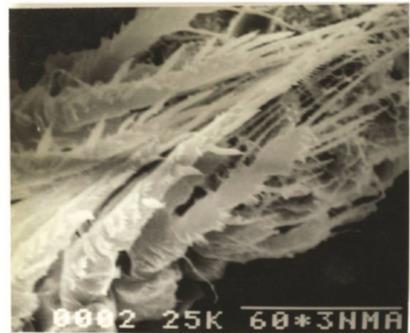


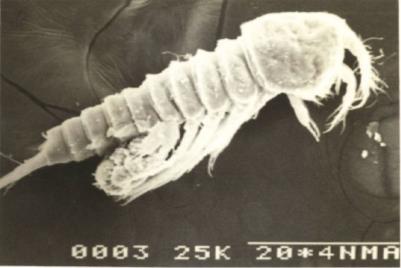


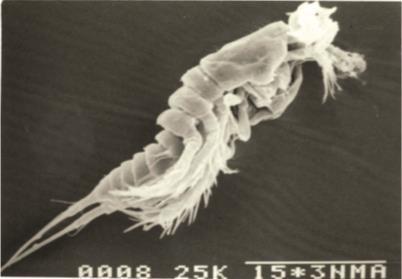
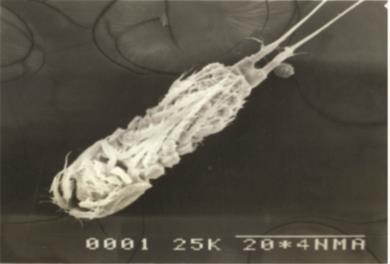
International Journal of Life Sciences Research ISSN 2348-3148 (online) Vol. 8, Issue 1, pp: (57-63), Month: January - March 2020, Available at: www.researchpublish.com
Mouthparts (Fig. G): Md coxa (Cx) elongated to form cutting edge with three teeth. Two spines present in the angle of Bsp and cutting edge of Cx. Bsp fused with Enp to form one segmented mandibular palp ending with two plumose terminal setae. Exp reduced as a spine. Mxl precoxal arthrite with seven bare setae terminally. Precoxal arthrite base
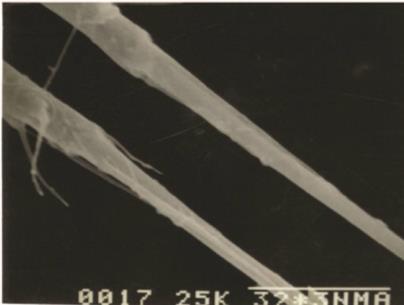
ISSN 2348-313X (Print)
International Journal of Life Sciences Research ISSN 2348-3148 (online) Vol. 8, Issue 1, pp: (57-63), Month: January - March 2020, Available at: www.researchpublish.com
narrower than the distal end. Precoxa Cx and Bsp fused. Enp bearing a plumose seta, and Exp with an inner plumose seta and two outer spines Mx syncoxa wide with one endite bearing two plumose setae and one unipinnate seta. Allobasis drawn out into a long claw and one spine, the claw bearing a row of eight teeth. Enp segment short, with three plumose setae terminally Mxp syncoxa bare. Bsp without ornamentation. Enp minute, triangular, bearing smooth claw and a single accompanying plumose seta.
P1-P4 (Fig. H): Exp 3-segmented and Enp 2-segmented; all the terminal setae of the terminal segment being longer than that segment. Cx without ornamentation. P1 Enp twice as long as Exp (Fig. I). Enp1 longer and stouter than first two Exp segments; with a unipinnate subterminal inner seta and two rows of spinules medially. Enp2 longer than Exp; with three rows of median spinules and a big terminal claw as long as Enp2, bearing 18 spinules on the outer margin. Exp1 with an outer plumose seta. Exp2 longer than Exp1, with a long plumose seta subterminally. Exp3 longer than the previous two and bears a short median plumose seta, a short subterminal plumose seta on the outer margin and three terminal plumose setae.
P2 Cx bare, Bsp with an outer seta. Exp1 with a row of spinules medially and a stout and short bipinnate spine terminally on the outer margin. Exp2 similar to the previous but with an additional plumose seta on the inner margin. Exp3 with two rows of spinules, a short bipinnate median spine, two subterminal plumose setae on the outer margin and one plumose seta on the inner margin plus two naked setae terminally. Enp1 with a row of spinules and Enp2 with similar spinules and three naked terminal setae
P3 Cx and Bsp without ornamentation. Exp as in P2. Enp1 as in P2 but Enp2 with two rows of spinules, one supra basal plumose spine, two long plumose spines on either margins medially and one plumose seta plus two long naked setae terminally.
P4 Exp1 as in P2 and P3 but the spine being longer. Exp2 with a row of spinules, a plumose seta subterminally on the inner margin and a bipinnate spine terminally on the outer margin. Exp3 with two rows of spinules, two stout bipinnate spines, of which one being medial and the other terminal, one medial plumose seta and three naked long terminal setae. P1-P4 setal formula:
Exp1 Exp2 Exp3 Enp1 Enp2
P1 0 0 0,3,2 1 0,1,0
P2 0 1 1,2,3 0 1,2,0
P3 0 0 1,2,3 0 3,2,1
P4 0 1 1,4,1 0 2,2,0
P5 Exp and Enp are fused, bearing four setae on the outer margin and three setae on the inner margin plus two spinules proximally on the inner margin
CR parallel, longer than broad, with smooth internal and external borders, four marginal setae and one appendicular seta (Fig. J)
Description of the male:
Body length (including CR): 612 ± 16 μm
Maximum body width : 180 ± 11 μm
Cphth length : 214 ± 14 μm
Body smaller than that of the female. Number of body somites ten, the first two urosomal somites being separate and not coalesced (Fig. C & D)
A1 (Fig. F) short sturdy, 5-segmented and geniculate. First segment with three spinules and two subterminal setae. Second segment is narrower than the first, bearing two median setae, two subterminal setae, three terminal setae and one aesthetasc. Third segment is highly enlarged, small has two setae and forms geniculation. Fourth segment narrow with two median setae. The last segment the narrowest with two median setae and six terminal setae (Fig. F)
Setal formula: I-2; II-7+Aes; III-2; IV-2; V-8
A2 (Fig. F) segments as in female but allobasis without the spinules; Exp with five setae joined at the base, Enp2 with one additional seta. P5 with only three setae. P6 is distinct on Ur2, minute, projecting as setiferous lobes
ISSN 2348-313X (Print)
International Journal of Life Sciences Research ISSN 2348-3148 (online) Vol. 8, Issue 1, pp: (57-63), Month: January - March 2020, Available at: www.researchpublish.com
The Superorder Harpacticoida includes two orders namely Longipediformes, and Harpacticiformes. The former contains almost exclusively marine species and the latter comprise families, which have representatives in fresh- as well as brackish continental and coastal waters (Dussart & Defaye, 1995). However, the great majority of species is assumed to be still unknown, mainly because large regions of the earth have not yet been extensively sampled.
The literature on Harpacticoida, prior to 1940 has been reviewed by Lang (1948) in his “Monographie der Harpacticiden”. Vervoort (1964) has given a key to the species of Onychocamptus and described closely related O. armiger Gurney, 1927 and O. gladiator Vervoort, 1964. Bodin (1997) has published a catalogue of the new harpacticoids.
According to Bodin (1997) the family Laophontidae T. Scott, 1905 includes the species inhabiting the intertidal zone or shallow subtidal waters, freshwaters and deep-sea hydrothermal vents and some species associated with invertebrate (e.g., holothurian and decapod) hosts. Huys (2009) listed following species as the direct child taxa for Laophontidae: Onychocamptus anomalus Reddy, 1984; O. armiger Gurney, 1927; O. bengalensis Sewell, 1934; O. besnardi Jakobi, 1954; O. chathamensis Sars, 1905; O. fratrisaustralis Gomez, 2001; O. gladiator Vervoort, 1964; O. heteropus Daday, 1903; O. horridus Norman, 1876; O. kliei Monard, 1935; O. krusensterni Schizas and Shirley, 1994; O. mohammed Blanchard and Richard, 1891; O. ponticus Serban and Plesa, 1957; O. taifensis Kikuchi, Dai and Ito, 1993; O. talipes Wilson, 1932 and O. vitiospinulosa Shen and Tai, 1963.
Coull (1977) has defined nine general body shapes. The body shape of O. bengalensis is „fusiform prehensile‟. This body form is seen in most of the species belonging to the families Laophontidae, Harpacticidae, Thalestridae, Diosaccidae, Ameiridae, and Canthocamptidae. A high degree of sexual dimorphism is expressed in O. bengalensis, a characteristic of most laophontids.
The size of O. bengalensis recorded in the present study is 737-783 μm for female and 596-628 μm for male. But Krishnaswamy (1957) has recorded comparatively lesser values, 700 μm for female and 480 μm for male.
The ornamentation of the copepod body surface has important taxonomic significance in intra generic systematics. Projecting forward from the anterior end of the cephalosome between the antennules is usually a rostrum. The rostrum varies in size from as long as the first three A1 segments to minute and barely visible. The rostrum may have a distinct articulation with the cephalon or it may be fused to it, with no articulation (Coull, 1977). The rostrum of O. bengalensis has no articulation. There is no spine on lateral swellings of cephalic somite as in O. armiger whereas lateral swellings on cephalic somite each with backwardly directed spine in O. gladiator Distal margins of abdominal somites do not have any teeth in O.bengalensis whereas distal margin of fourth abdominal somite dorsally with 3 or 4 bifid teeth in O. horridus and 2 bifid teeth in O. brevispinosus Sars.
In males, the body is smooth in O. bengalensis; smooth and haired in O. mohammed; and with big backwardly directed spines in O. horridus.
The A1 in harpacticoids is short (4-10 segmented) and usually bears 1-2 aesthetascs. The Laophontids, other than O.bengalensis, like Arenolaophonte, Hamilaophonte, Klieonychocamptus, Phycolaophonte, Xanthilaophonte trispinosa and Mielkiella spinulosa (George, 1997) show 6-segmented A1. The A1 is 5-segmented in O.bengalensis whereas it is 6segmented in O. armiger and O. gladiator. The second segment of A1 in O. bengalensis is bulged in the middle whereas it has an externally directed spine in O. gladiator and is smooth in O. armiger (Vervoort, 1964). In males the A1 has a well-pronounced and well-developed swollen segment about its mid length in O. bengalensis and the swollen segment with a short conical process bearing an aesthetasc in O. armiger
The A2 in harpacticoids is biramous and consists of a Bsp, Enp and a small (1 to 6-segmented) Exp. The allobasis often appears as having 2-segments and basis 3-segmented. In O. bengalensis, allobasis is formed, which is similar to many Laophontids but differ from Stygolaophonte Lang, 1965 and Mielkiella George, 1997. The A2 Enp has six apical setae differing from Afrolaophonte Chappuis, 1960, Coullia Hamond, 1973, Harrietella T. Scott, 1906, Hemilaophonte, Lobitella Monard, 1934, Loureirophonte Jakobi, 1953, Platychelipus Brady, 1880, Raptolaophonte Cottarelli and Forniz, 1989, Stygolaophonte and Mielkiella George, 1997, which have seven apical setae.
Md, Mxl, Mx and Mxp are complex and specialized feeding structures, which furnish useful specific characters. The complete Md consists of a precoxa (with a toothed cutting edge), a coxa-basis, an Exp, and an Enp. In O. bengalensis, Cx is elongated to form cutting edge. Mxl consists a precoxal arthrite with seven setae. Mx consists of a syncoxa with endites, a Bsp and an Enp. The endite number is one in O. bengalensis Allobasis is drawn out into a long claw. The mxp
ISSN 2348-313X (Print)
International Journal of Life Sciences Research ISSN 2348-3148 (online) Vol. 8, Issue 1, pp: (57-63), Month: January - March 2020, Available at: www.researchpublish.com
in O. bengalensis is with minute, triangular enp , bearing smooth claw and a single accompanying plumose seta whereas in O. gladiator enp of mxp is a huge claw and in O. armiger it is slender (Vervoort,1964).
P1-P5 are the most widely used appendages for taxonomy. P1-P4 are generally constructed in a similar manner, where as P5 is usually fused and morphologically dissimilar from others. P1-P4 are generally constructed with a coxa, a basis, an outer Exp and an inner Enp. The Exp and Enp vary in length, the number of segments and setation depending on species. In O. bengalensis the P1-P4 have three Exp and two Enp segments. O. bengalensis differs in this character from other Laophontid genera, which have 2- segmented P1 Exp, such as Archilaophonte Willen 1995, Arenolaophonte, Esola hirsuta Thompson and A. Scott, 1903, Folioquinpes Fiers and Rutledge, 1990, Heterolaophonte furcata Noodt, 1958, H. serratula Mielke, 1981, Hoplolaophonte Hamond, 1973, Klieonychocamptus, Laophonte Philippi, 1840, Loureirophonte, Microlaophonte Vervoort, 1964, Mielkiella spinulosa George, 1997, Myctyricola Nicholls, 1957, Phycolaophonte, Platychelipus, Psammolaophonte Wells, 1967, Quinquelaophonte Wells, Hicks and Coull, 1982, Raptolaophonte, Stygolaophonte and Xanthilaophonte carcinicola Fiers, 1991 (George, 1997).
The P1 exp is very small and 2-segmented in O. armiger and O. gladiator In males, the P3 enp2 is without spiniform external prolongation in O. bengalensis, O. cathamensis and O. talipes whereas it is with external spiniform prolongation in O. besnardi, O. mohammed and O. horridus P4 exp3 in O. bengalensis has two external marginal spines as in O. horridus but differs from O. mirabilis which has three
The P5 in most harpacticoids has a non-segmental plate like structure called the baseoendopod (Benp) to which the leaf like Exp is attached. There are a few genera in which P5 Exp is segmented. Often however, the left and right Benp are fused together forming a continuous plate across the entire ventral side of the body. The male appendage is constructed similarly to that of the female but is always much smaller and less ornate. The female P5 are often used as a broad pouch or as a protecting flaps for the developing externally attached eggs (Coull, 1977). The P5 of O. bengalensis is nonsegmented with difference in the setal number between sexes. According to Hamond (1973) fusion of Benp and exp of P5 in female O. bengalensis is one highly diagnostic character. According to Vervoort (1964) exp is more or less fused with benp of P5 and without articulation in O. besnardi also However the benp and exp of P5 is distinctly articulating in O. talipes and O. mohammed P5 of O. bengalensis has four setae on the outer margin and three setae on the inner margin plus two spinules proximally on the inner margin whereas in O. talipes the setae are spiniform.
Males have P6, which are not visible in females The P6 forms armature of the genital plate and is composed of two setae in O. armiger.
The CR articulated to the last urosomal somite and have at least one major seta (usually two setae) projecting posteriorly. The CR setae of O. bengalensis are two pairs in number. Most species of Onychocamptus tolerate and even thrive in marginal habitats such as oligohaline lakes and lagoons (Schizas & Shirley, 1994). O. mohammed, which is cosmopolitan, was predominant in a oligohaline lake in China (Shen & Tai, 1962). Hamond (1973) reported O. bengalensis from brackish lagoons north of Sydney. O. krusensterni occurs in an estuarine lagoon north of the arctic circle which is subject to extreme weather conditions. The possible affinity of this genus with oligohaline and hypersaline environments warrants further study (Schizas & Shirley, 1994).
In the recent past, Arunachalam and Nair (1988) found O. bengalensis associated with the seagrass halophila ovalis in Ashtamudi Estuary, southwest coast of India. Mirabdullayev & Ishida (2002) recorded this species in the Aral Sea region. Saboor (2003) has studied the occurrence, biology and culture of this species.
Panikkar and Aiyar (1937) studied the brackish water fauna and Srinivasan and Raghunathan (1981) studied the zooplankton of Adyar Estuary but have not reported O. bengalensis.
The O. bengalensis occurrence was recorded from May 1998 to June 1999 in the Adyar Estuary. It was available during high-tide as well as low-tide, at the mouth of the estuary as well as upstream in the Adyar River. Following are the physical and chemical parameters recorded during the study period: Temperature 26-34 ˚C, pH 7-8, dissolved oxygen 04.5 ml/L, free carbon dioxide 4.9-55.9 ppm, total alkalinity 45- 310 mg/L, Salinity: 0.6- 36.3ppt
The lifespan of O. bengalensis females ranges from 35 to 69 days. Precopulatory mate guarding behavior is present. The female sex ratio is 61-71%. The brood size is 20-36 eggs per ovisac; Number of clutches produced after single mating is 8-10 ovisacs; and generation time is 14-14.5 days. Due to their appropriate size and biochemical composition the naupliar and copepodid stages of O. bengalensis form a suitable livefood for the larvae of commercially important shellfish and finfish.
ISSN 2348-313X (Print)
International Journal of Life Sciences Research ISSN 2348-3148 (online) Vol. 8, Issue 1, pp: (57-63), Month: January - March 2020, Available at: www.researchpublish.com
We are grateful to Dr. H. U. Dahms for his help in identification of the species, to Dr. K. H. George for providing us with relevant literature and to Dr. K. Sivakumar and Dr. M. Farzana Yasmeen for their help.
[1] Arunachalam, M. & Nair, N.B (1988) Harpacticoid copepods associated with the seagrass Halophila ovalis in the Ashtamudi Estuary, south-west coast of India. Hydrobiologia, 167/168, 515-522
[2] Ax, P. (1984) Das Phylogenetische System. Gustav Fischer Verlag, Stuttgart, 1, 349
[3] Bayly, I. A. E. & Williams, W. D. (1966) Chemical and biological studies on some saline lakes of south-east Australia. Australian Journal of Marine and Freshwater Research, 17, 177-228.
[4] Bodin, P. (1997) Catalogue of the new marine harpacticoid copepods Documents de Travail de l' Institut Royale des Sc 1-304.
[5] Coull, B.C. (1977). Marine flora and fauna of the Northeastern United States. Copepoda: Harpacticoida. NOAA Tech. Report NMFS, 399, 1-48.
[6] Dussart, B.H. & Defaye, D. (1995) Copepoda: Introduction to the Copepoda. In: Guides to the identification of the microinvertebrates of the continental waters of the World. pp. 1-277. SPB Academic Publishing, Amsterdam
[7] George, K.H. (1997) Miekiella spinulosa gen.n. sp.n., a new taxon of the Laophontidae (Copepoda, Harpacticoida) from Porvenir (Tierra del Fuego, Chile). Microfauna Marina 11, 71-86.
[8] Hamond, R., (1973) The harpacticoid copepods (Crustacea) of the saline lakes in southeast Australia, with special reference to the Laophontidae. Records of the Australian Museum 28, 393-420
[9] Huys, R. & Boxshall, G.A. (1991) Copepod Evolution The Ray Society, London, 1-468.
[10] Huys, R., Gee, J.M., Moore C.G. & Hamond, R. (1996) Marine and Brackish Water Harpacticoid Copepods. Part 1. Keys and notes for identification of the species. In: R.S.K. BARNES & J.H. CROTHERS (eds.), Synopses of the British Fauna 51, 1-352.
[11] Huys, R. (2009). Onychocamptus Daday, 1903. In: T. C. Walter & G. Boxshall (eds.), World Copepoda database. Accessed through: World Register of Marine Species at http://www. marinespecies.org/
[12] Krishnaswamy, S. (1957) Studies on the Copepoda of Madras (Ph.D. thesis). pp. 1-168. University of Madras
[13] Lang, K. (1948) Monographie der Harpacticiden Nordiska Bokhandeln, Stockholm 1-1682.
[14] Mirabdullayev, I. M. & Ishida, T. (2002) Records of tropical harpacticoid Onychocamptus bengalensis (Sewell, 1934) (Crustacea, Copepoda) in the Aral Sea region. Tethys Aqua Zoological Research, 1, 149-154.
[15] Odum, E.P. (1971). Fundamentals of Ecology, III ed. pp. 1-362. W.B. Saunders Company, USA.
[16] Panikkar, N.K. & Aiyar, R.G. (1937) The brackish water fauna of Madras. Proc. Indian Academic Science B. 6, 284-337.
[17] Saboor, A. (2003). Studies on estuarine harpacticoid copepods (Ph.D. thesis). pp. 1-13. University of Madras.
[18] Sewell, R. B. S. (1934). A study of the fauna of the Salt Lakes, Calcutta. Records of the Indian Museum., 36, 45-121
[19] Schizas, N. V. & Shirley, T. C. (1994). Onychocamptus krusensterni (Copepoda, Harpacticoida, Laophontidae)- A new species from Krusenstern Lagoon, Alaska. Crustaceana 66, 227-239
[20] SHEN, C. J. & TAI, A. Y (1962) The Copepoda of the Wu Li Lake, Wu-Sih, Kiangsu Province. III. Harpacticoida. Acta. Zoological Sinica 14, 393-410
[21] Srinivasan, M. & Raghunathan, M.B. (1981) Observation on the zooplankton and hydrography at Adyar estuary, Madras during solar eclipse, 1980. Ind. J. Zootomy. 22, 47-51.
[22] Vervoort, W. (1964). Free-living Copepoda from Ifaluk Atoll in the Caroline Islands with notes on related species. Rijksmuseum van Natuurlijke Historie, Leiden, ZNetherlands. U.S. National Museum Bulletin 236, 357-370